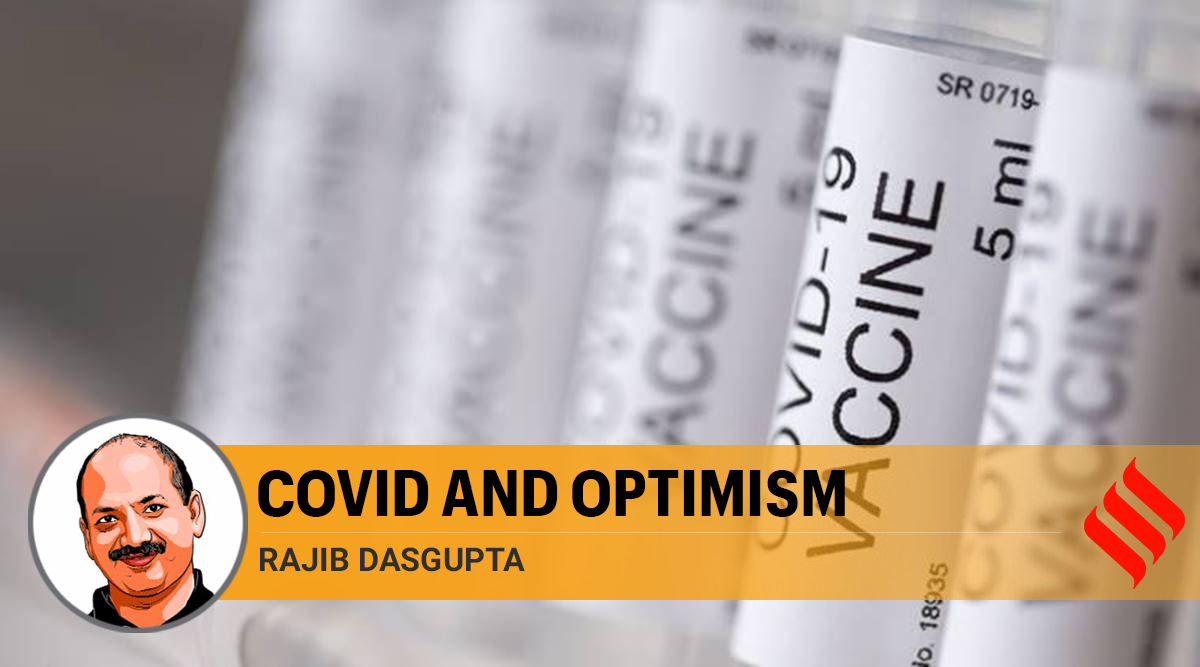 Governments are promising a quick-fix by accelerating vaccine production to historically unprecedented extents.
Governments are promising a quick-fix by accelerating vaccine production to historically unprecedented extents.With COVID vaccines on the horizon, vaccine optimism has made its mark in the contemporary gold standard of sentiments: Stock markets are rallying back to all-time highs. The optimism seems to be all-pervasive — from politicians and policy-makers to the common man.
Is this optimism unfounded? Not entirely, as some features of SARS-CoV-2 (the causative agent) suggest. Clinical trials have demonstrated rising anti-spike antibodies that block virus infection in cells under laboratory conditions. With the spike protein having multiple locations where antibodies can bind and neutralise the virus, mutations in the pathogen are not likely to be easily successful in negotiating the vaccine. Several candidate vaccines have demonstrated success in Phase I and Phase II trials. Phase III is the crucial phase where it will be tested on tens of thousands of individuals to determine if it works to prevent infection with SARS-CoV-2 (efficacy) and that it is safe (safety). The true test of the safety profile is only through continued surveillance (after introduction in the market and/or a programme), adverse event monitoring and post-marketing surveillance systems. Reality check: Other coronavirus infections such as SARS and MERS have now been studied for a couple of decades but there are no licenced effective vaccines.
Governments are promising a quick-fix by accelerating vaccine production to historically unprecedented extents. An interesting case in point is Operation Warp Speed that aims to deliver 300 million doses of a safe, effective vaccine in the US by January 2021. The White House has reportedly committed $12 billion to six candidate vaccines. The worry is not that adequate numbers of research participants are not inducted into the trials but that the companies are being forced to condense an often decade-long process into a maximum of six to eight months (by funding multiple simultaneous trials) with potentially serious consequences for efficacy and safety.
The global health endgame is to make the vaccine equitably available and accessible worldwide. At the same time, a range of COVID-specific vulnerabilities have surfaced from deeply embedded health inequities. The WHO Director General recognises that “supply nationalism exacerbated the pandemic and contributed to the total failure of the global supply chain” and urged that “we need to prevent vaccine nationalism”. The global intellectual property system allocates the rights of the vaccine to the inventor or owner for up to 20 years. The WHO and the EU are reportedly exploring options of buying medicinal rights and establishing a pool of patents while nation-states may prefer to invoke “compulsory licencing”. The WHO and other international organisations have set up a coalition, the COVID-19 Vaccines Global Access (COVAX) Facility that seeks to attract rich countries to sign on by reducing their own risk that they are betting on the wrong vaccine candidates — the success of this model is yet to be tested fully. Even if there are broad agreements, they will be riddled with complex institutional arrangements for vaccines to be procured and made available at the point of care.
Opinion: Tame the pandemic, safely
In the hope that the successful vaccines are poised in the next few months to begin their journey from the horizon to the health centres, what will be the demand-side story? The WHO’s “strategic allocation” approach is targeted at health workers, people over 65 years and those with co-morbidities that put them at a higher mortality risk from COVID-19. The US-CDC’s Advisory Committee on Immunisation Practices (ACIP) has developed a rough five-tier scheme; the full ACIP is debating a wider set of questions: Race or ethnicity (COVID-19 had a disproportionate impact on African-American, Hispanic and Native American communities); the poor, as they have less access to healthcare, live in more crowded conditions, and suffer more if they become sick and must take time off work; custodial populations such as prisoners and those in homeless shelters; and teachers who are indoors with large groups of students. India’s National Technical Advisory Group on Immunisation (NTAGI) shall presumably be tasked with the country’s prioritisation strategies. It needs to recognise and accept diverse vulnerabilities using social epidemiology and public health ethics considerations, even while recognising that one cannot wait for perfect data.
The Indian position was recently articulated by Prime Minister Narendra Modi in his Independence Day speech: “To make it available to every person in the shortest possible time.” The confidence perhaps stems from the fact that the health minister is hoping that “if everything goes well, India will get a coronavirus vaccine by the end of this year”, and an additional month for production. There are also reports of talks with several global vaccine makers to get priority access to any vaccine produced first. The current strategy is to enable vaccine production and make it market-ready while regulatory processes and logistic requirements are ironed out.
The promise of reaching every person has inordinately raised vaccine optimism and expectations. However, there are several “wicked problems” to encounter and negotiate. Solving wicked problems typically entails working on the intersections of incomplete (or contradictory) knowledge, negotiating a number of diverse people and opinions, overcoming a large economic burden, and navigating the interconnected nature of these problems with other problems. There will also be dilemmas of prioritised access and the criteria to address competing claims. This will require balancing ethics and economics, intellectual property rights and public good, and private production and public distribution. These are inordinately demanding challenges that require a balance of imagination and realism — if we knew how to do that, the task wouldn’t have been ambitious.
This article first appeared in the print edition on August 29 under the title “Covid and optimism.” Dasgupta is Chairperson, Centre of Social Medicine & Community Health, Jawaharlal Nehru University, Delhi.